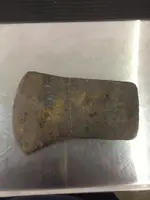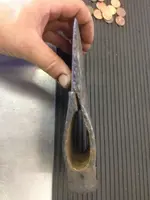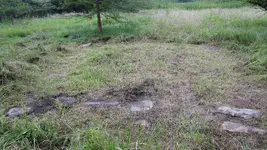Axe heads were made from 4 separate parts before the turn of the century, the sides are called the cheeks and they were hand forged to the bit (the sharp edge), this cutting end was a different, more hardened steel pounded into the cheeks, then the back of the axe which was a much softer material was hand forged between the cheeks at the other end. Where your axe split was pretty common as when an axe head was hafted onto the handle by the manufacturer, care was taken. But once the handle wore out, the person re-hating would pound in a wedge that was too big and it would put tremendous stress on the cheeks causing the cheek material to eventually fail upon striking. You can tell a lot about an axe head by looking at it, firstly I can say yours was well used as it shows the very rounded curvature of the bit from being sharpened so many times. The more it was sharpened, the more rounded the cutting edge gets. Secondly, most axe heads sold by general stores between 1860 - 1930 had makers marks, I see none in your photos . . . .which is a clue that a blacksmith did In fact make it. But keep in mind that factory made axe heads in the same time period were made exactly the same way as the lone blacksmith would have made it. All hand forged, the difference being one used a hammer and the factory's used machines that did the work of the blacksmiths hammer.







